外研版高中英语必修4说课稿 Module2 Traffic Jam
- 格式:pdf
- 大小:264.66 KB
- 文档页数:6
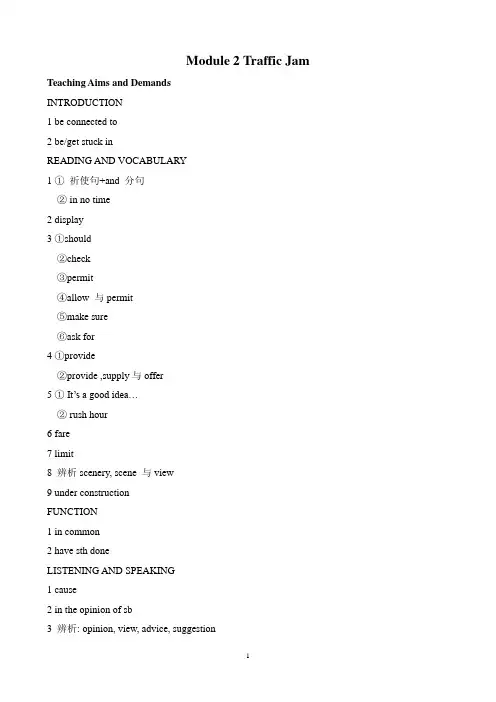
Module 2 Traffic Jam Teaching Aims and DemandsINTRODUCTION1 be connected to2 be/get stuck inREADING AND VOCABULARY1 ①祈使句+and 分句② in no time2 display3 ①should②check③permit④allow 与permit⑤make sure⑥ask for4 ①provide②provide ,supply与offer5 ①It’s a good idea…② rush hour6 fare7 limit8 辨析scenery, scene 与view9 under constructionFUNCTION1 in common2 have sth doneLISTENING AND SPEAKING1 cause2 in the opinion of sb3 辨析: opinion, view, advice, suggestionPRONUNCIATION1 辨析: seem, look 与appear2 辨析: aloud, loud 与loudly3 Why not…4 not only …but also5 had betterSPEAKING1 room2 辨析: space 与roomWRITING1 as a result2 mean to do 与mean doing3 辨析: besides, except 与except forEVERYDAY ENGLISH1 no way2 drive sb madCULTURAL CORNER1 suffer2 so… that…3 agree4 even if 与even thoughGRAMMAR祈使句1 give advice2 give instructions3 switch off4 keep coolTeaching paper for period 1: Introduction and ReadingStep1:Lead-in1>Present different kinds of pictures of means of transport and ask questions :①Which of them do you prefer to take to go around the city?②Can you name all of them in English?2> Let students pay more attention to the words: coach and trolleybus. Explain them and letthe students follow you.Step 2: Match the words with their definitionsAfter some pictures of means of transport, the students are familiar with the words. Theteacher can ask students to do the exercise individually or divide the whole class intogroups and have a competition.Step 3: Make up sentences1>Ask students to make short sentences according to the example. They should makesentences according to the fact.2>Or they may ask each other questions in pairs. For example:Which means of transportation do you prefer?Do you always take a bus to school?Step 4: Share your answers with your partner.Encourage the students to speak English as much as possible to practice their oral English.During this period some language mistakes should be allowed as long as they can expresstheir meanings.Step 5: Match the words with their meanings.This part is provided as a warming-up for the upcoming reading. Because by doing thisthey can get more familiar with some of the new words. Teachers can call back the answer as a whole class.Step 6: ListeningListen to the tape for the text and find what means of transportation are mentioned in thepassage. This step can save some time and test the students’ listening sk ills as well .Step 7: Fast-readingRead the text fast and try to get the main idea of the passage. Then fill in the chart. Allow them to discuss the questions if they find it difficult.Step 8: Detail-readingRead the text carefully again and answer the questions.Teachers may allow students to finish this part in pairs.Make sure they answer the questions in complete sentences.Step 9: Fill in the blanksAfter three times of going through the passage, students may be very similar with theontents. So this time, let them close the books and fill in the blanks.This step may be offered as a small competition to see who can fill in the form correctly. Step 10: HomeworkWrite the passage in step 9 on your exercise book and hand it in.Teaching paper for period 2: Listening, Everyday English and SpeakingStep 1: Lead-inWe’ll think of some places of interest whenever Beijing is mentioned: the Summer Palace, the Forbidden City , the Great Wall and so on. (present some pictures of these places of interest at the same time) But have you thought of the traffic in Beijing. What do people in Beijing think of the traffic in Beijing? In order to solve this question, let’s come to listening.Step2: Listen for the first timeListen to people of Beijing speaking about traffic problems in the city.Before you listen, tick the topics you think they will talk about. Thenlisten to the tape to check the answers.Step3: Listen for the second time1>Listen again and match the traffic situations with the speakers.2>Choose the correct sentences.Step4: Listen for the third timeListen to the tape for the third time and answer the questions in pairs.Step5: Everyday EnglishThe sentences are all taken from the listening passage. So it would be better to finish thisart just after listening. If the students in your class are advanced ones, you can let them tomake up a short dialogue using some of the expressions.Step6: SpeakingThis part is also related to the listening passage.There are some expressions for giving advice:1>Why not …2>They/ We should /shouldn’t …3>They/We could /should…3>Why don’t you…?Encourage students to use these expressions to form several sentences to advise how to improve the traffic situation in the city of Beijing.Step 7: HomeworkWrite the sentences on your exercise book.Teaching paper for period 3: Cultural Corner, Grammar and Writing]Step1: Lead-in for Cultural CornerLead into the passage by asking two questions:1>What problem will come about if a city has too much traffic?2>Suppose you are a mayor of London, what measure will you take to solve the trafficproblems caused by too much traffic?Encourage them to open their mouth and speak English as much as they can , and thus students and teachers can enjoy a lively atmosphere.Step2: read and answerRead the passage quickly and answer the questions:1 What is a congestion charge?2 Why are there traffic jams in London?Step3: read again and answer more questionsWork in groups and answer the following questions.1 What are people’s attitudes towards this policy?2 Would a congestion charge be a good idea in your town?Step4: Language pointsExplain some language points in the passage and for some of them some students can be asked to answer some of your questions.Step5: Grammar1>Present some pictures to lead into IMPERATIVES we’re going to learn.2>Explain some detail knowledge.3>Do some exercise to consolidate what has been learned.Step6: WritingRead the passage on P18 and answer the following 5 questions:1 How many problems does the writer talk about?2 What are the causes of the problems?3 How many solutions does the writer find?4 Who are they in They should close the city center?5 Why does the writer divide the passage into two parts? Step7: HomeworkWrite a similar passage about your town.。
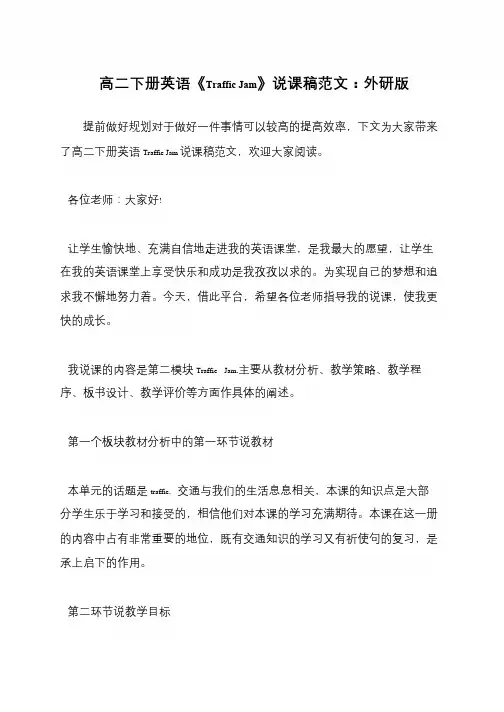
高二下册英语《Traffic Jam》说课稿范文:外研版
提前做好规划对于做好一件事情可以较高的提高效率,下文为大家带来了高二下册英语Traffic Jam 说课稿范文,欢迎大家阅读。
各位老师:大家好!
让学生愉快地、充满自信地走进我的英语课堂,是我最大的愿望,让学生在我的英语课堂上享受快乐和成功是我孜孜以求的。
为实现自己的梦想和追求我不懈地努力着。
今天,借此平台,希望各位老师指导我的说课,使我更快的成长。
我说课的内容是第二模块Traffic Jam.主要从教材分析、教学策略、教学程序、板书设计、教学评价等方面作具体的阐述。
第一个板块教材分析中的第一环节说教材
本单元的话题是traffic. 交通与我们的生活息息相关,本课的知识点是大部分学生乐于学习和接受的,相信他们对本课的学习充满期待。
本课在这一册的内容中占有非常重要的地位,既有交通知识的学习又有祈使句的复习,是承上启下的作用。
第二环节说教学目标。
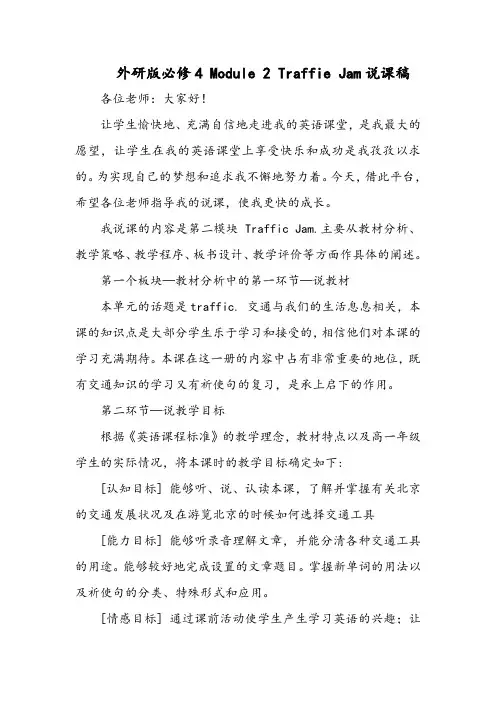
外研版必修4 Module 2 Traffie Jam说课稿各位老师:大家好!让学生愉快地、充满自信地走进我的英语课堂,是我最大的愿望,让学生在我的英语课堂上享受快乐和成功是我孜孜以求的。
为实现自己的梦想和追求我不懈地努力着。
今天,借此平台,希望各位老师指导我的说课,使我更快的成长。
我说课的内容是第二模块Traffic Jam.主要从教材分析、教学策略、教学程序、板书设计、教学评价等方面作具体的阐述。
第一个板块—教材分析中的第一环节—说教材本单元的话题是traffic. 交通与我们的生活息息相关,本课的知识点是大部分学生乐于学习和接受的,相信他们对本课的学习充满期待。
本课在这一册的内容中占有非常重要的地位,既有交通知识的学习又有祈使句的复习,是承上启下的作用。
第二环节—说教学目标根据《英语课程标准》的教学理念,教材特点以及高一年级学生的实际情况,将本课时的教学目标确定如下:[认知目标] 能够听、说、认读本课,了解并掌握有关北京的交通发展状况及在游览北京的时候如何选择交通工具[能力目标] 能够听录音理解文章,并能分清各种交通工具的用途。
能够较好地完成设置的文章题目。
掌握新单词的用法以及祈使句的分类、特殊形式和应用。
[情感目标] 通过课前活动使学生产生学习英语的兴趣;让学生敢于、乐于开口,积极参与交流,在讨论中培养合作意识和竞争意识;让学生在学习的过程中,看到交通给人类带来的利与弊在给人带来交通便利的同时,要看到交通事故的危害,提醒身边的人注意交通安全第二个板块—说教学策略本课主要采用情景教学和交际功能法以及多媒体计算机辅助课堂教学,充分发挥教师的主导作用和学生的主体作用,利用现代教育技术优化教学过程,通过课件为学生创设更多生动活泼的语言环境,把学生吸引到活动中去,并激发他们主动参与学习的欲望内。
努力培养学生的自学能力,把学习的钥匙交给学生,在传授知识的同时授以科学的思维方法。
不仅要使学生学会,更要使学生学会学,因此,在课堂教学中巧妙运用教学艺术,适当安排自学、小组讨论、全班讨论、竞赛等活动,鼓励学生开口就说,提高运用语言的能力,变“讲堂”为“学堂”,变“要我学”为“我要学”,从而从根本上打破传统的课堂教学方法,建构一种新型的现代教育模式,使学生在更轻松更愉快的环境下实现更多的信息交流,真正做到快快乐乐学英语,扎扎实实打基础,向四十分钟要质量,向课堂教学要效益的最终目的。
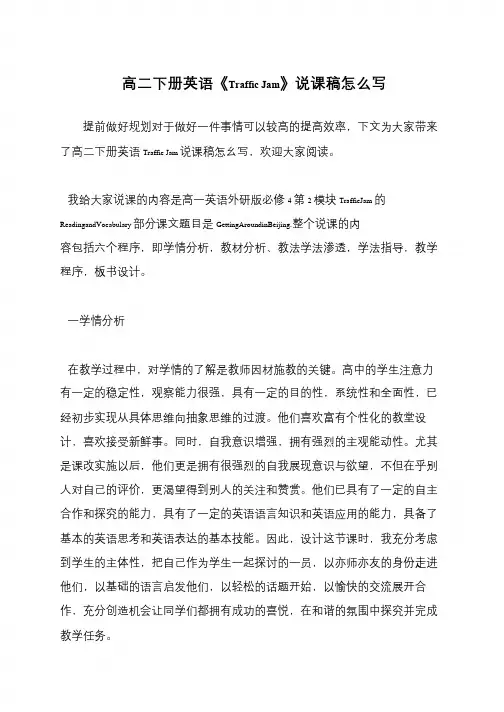
高二下册英语《Traffic Jam》说课稿怎么写
提前做好规划对于做好一件事情可以较高的提高效率,下文为大家带来
了高二下册英语Traffic Jam 说课稿怎幺写,欢迎大家阅读。
我给大家说课的内容是高一英语外研版必修4 第2 模块TrafficJam 的ReadingandVocabulary 部分课文题目是GettingAroundinBeijing.整个说课的内容包括六个程序,即学情分析,教材分析、教法学法渗透,学法指导,教学
程序,板书设计。
一学情分析
在教学过程中,对学情的了解是教师因材施教的关键。
高中的学生注意力
有一定的稳定性,观察能力很强,具有一定的目的性,系统性和全面性,已
经初步实现从具体思维向抽象思维的过渡。
他们喜欢富有个性化的教堂设
计,喜欢接受新鲜事。
同时,自我意识增强,拥有强烈的主观能动性。
尤其
是课改实施以后,他们更是拥有很强烈的自我展现意识与欲望,不但在乎别
人对自己的评价,更渴望得到别人的关注和赞赏。
他们已具有了一定的自主
合作和探究的能力,具有了一定的英语语言知识和英语应用的能力,具备了
基本的英语思考和英语表达的基本技能。
因此,设计这节课时,我充分考虑
到学生的主体性,把自己作为学生一起探讨的一员,以亦师亦友的身份走进
他们,以基础的语言启发他们,以轻松的话题开始,以愉快的交流展开合
作,充分创造机会让同学们都拥有成功的喜悦,在和谐的氛围中探究并完成
教学任务。
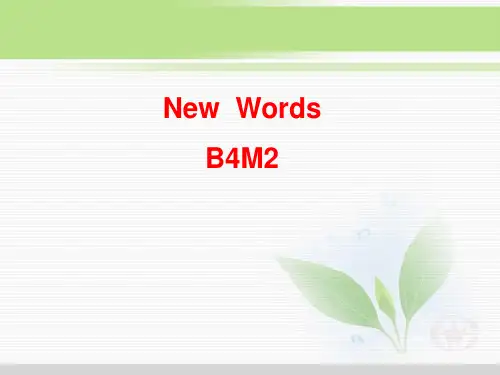
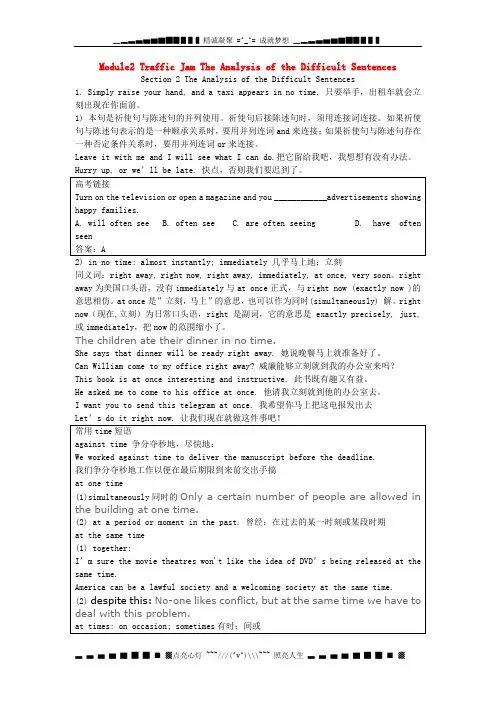
Module2 Traffic Jam The Analysis of the Difficult SentencesSection 2 The Analysis of the Difficult Sentences1. Simply raise your hand, and a taxi appears in no time. 只要举手,出租车就会立刻出现在你面前。
1) 本句是祈使句与陈述句的并列使用。
祈使句后接陈述句时,须用连接词连接。
如果祈使句与陈述句表示的是一种顺承关系时,要用并列连词and来连接;如果祈使句与陈述句存在一种否定条件关系时,要用并列连词or来连接。
Leave it with me and I will see what I can do.把它留给我吧,我想想有没有办法。
Hurry up, or we’ll be late. 快点,否则我们要迟到了。
2) in no time: almost instantly; immediately 几乎马上地;立刻同义词:right away, right now, right away, immediately, at once, very soon。
right away为美国口头语,没有immediately与at once正式,与right now (exactly now )的意思相仿。
at once是”立刻,马上”的意思,也可以作为同时(simultaneously) 解。
right now(现在,立刻)为日常口头语,right是副词,它的意思是exactly precisely, just,或immediately,把now的范围缩小了。
The children ate their dinner in no time.She says that dinner will be ready right away. 她说晚餐马上就准备好了。
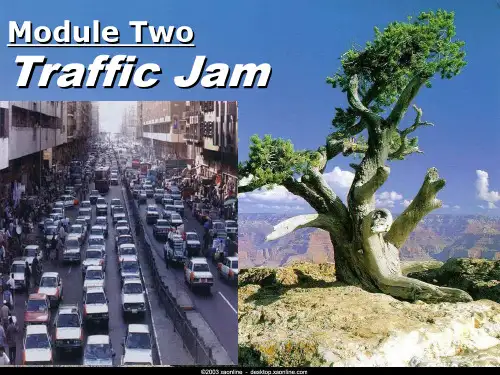
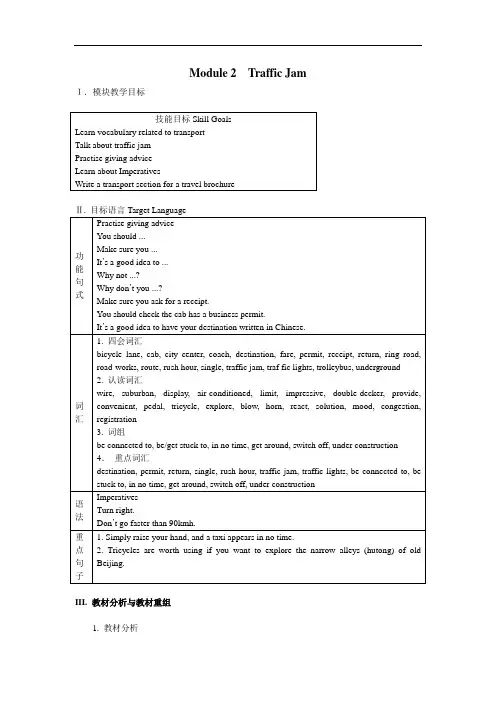
Module 2 Traffic Jam I.模块教学目标III. 教材分析与教材重组1. 教材分析交通堵塞问题是一个世界性的难题。
交通堵塞不但迫使出行者浪费时间,而且造成燃油浪费和空气污染,如何解决交通堵塞问题,成为各国人民关心的热点。
本模块以交通堵塞为话题,以词汇为主线,从听、说、读、写各方面围绕交通这个社会热点问题对学生进行语言训练。
通过本模块的学习,学生不仅能够掌握与交通有关的词汇,还可以就有关交通方面的问题提出建议,为治理交通堵塞问题献计献策。
1.1 INTRODUCTION 通过复习和学习一些与交通有关的词汇,为本模块的学习奠定良好的基础。
1.2 READING AND VOCABULARY介绍北京几种常见的交通工具。
1.3 FUNCTION练习就交通方面为游客提建议的句型。
1.4 LISTENING AND SPEAKING部分是关于北京交通问题的讨论。
1.5 VOCABULARY学习与交通有关的合成词。
1.6 PRONUNCIATION朗读5个和交通有关的句子,练习辅音省略技巧。
1.7 GRAMMAR由三部分组成。
第一部分通过辨别路标来判断祈使句的功能;第二部分练习使用祈使句;第三部分练习用祈使句表达塞车时该做与不该做的事情。
1.8 SPEAKING要求学生通过小组活动,提出家乡交通存在的问题,并就改善交通状况提出建议。
1.9 WRITING包括一篇范文。
该文介绍了作者家乡的交通状况,由于车多而造成交通堵塞,空气污染,事故增多,并就此问题提出解决办法。
读后要求学生根据范文写一篇关于自己家乡交通现状的文章。
通过对范文的分析,同学们清楚了文章的结构和内容要点,所以写一篇相似的文章是一件轻而易举的事情。
教材这样编排降低了写作的难度,激发了学生的写作热情。
2.0 EVERYDAY ENGLISH部分涉及交通方面常用的句型。
2.1 CULTURAL CORNER是一篇关于伦敦怎样治理市中心交通堵塞的文章,可以开阔同学们的思维,了解世界不同地域对解决交通堵塞这一世界难题的不同方法,并找到符合国情的解决交通问题的好办法。

Module2 Traffic Jam ReadingPart One Teaching DesignPeriod 1 Reading--Getting Around in Beijing■Goals●To learn to read passages with Imperatives about traffic jams●To learn to read with strategies■ProceduresStep 1: Warming up by defining traffic jamWhat is traffic jam or traffic congestion?Traffic jam is a number of vehicles blocking one anotheruntil they can scarcely move.Traffic congestion occurs when the volume of traffic on a roadway is high enough to become detrimental to its performance. In congested conditions, vehicle speeds are reduced, increasing drive times. These conditions are also more frustrating for drivers (see road rage), and automobile accidents may be more frequent. Furthermore, vehicles burn unnecessary fuel when stuck at idle. A period of extreme traffic congestion is known as a traffic jam.Warming up by looking and sayingLook at the pictures on the screen. They are pictures of traffic jam. Could you say something about traffic jam?Step 1: Before you readPlease go over the word list for this module, paying attentionto the pronunciation of the word, the relationship between itspronunciation and its spelling.Step 2: While you read1.Type of writing and summaries of Getting Around in BeijingGetting Around in BeijingTaxis Buses andtrolleybusesMinibuses Underground PedicabsTaxis are on the streets 24 hours a day. Publictransportprovides acheap way toget around inBeijing.Minibuses withseats for 12passengersoffer analternative toexpensivetaxis andThere are fourundergroundlines inBeijing, andseveral linesare underconstruction.Tourists likethesehuman-pedalled“tricycletaxis”, butthey can beexpensive.2. A diagram of Getting Around in Beijing3. Complete the article with one word in each blankTaxis are on the streets in Beijing 24 hours a day. You simply _1_ your hand, and a taxi will appear in front of you in no time. 20,000 buses and _2_ in Beijing provide a cheap way to get around. But you will be displeased as they can _3_ very crowded sometimes. Avoiding public transport during the rush _4__ may be agood idea. Then you might decide to take a minibus with seats for 12 _5_. It offers an alternative to expensive taxis and crowded public transport in some _6_. In Beijing you find four underground lines and several lines more under construction. Underground _7_ are fast and convenient, but rush hours can be frightening. Tourists to Beijing _8__ human-pedalled “tricycle taxis”, but th ey may not be as cheap as other _9_ of transport. Tricycles are worth taking if you want to see the narrow _10_ (hutong)4. Answer the reading comprehension questions according to the text1. Taxis are usually red in color, and they display the _____ on the _____.A. price pre kilometer, windowB. routes, doorC. signs, backD. words of warning, front2. Fares for _____ are cheap, starting at 1 yuan. Air-conditioned buses cost more.A. taxisB. underground trainsC. minibusesD. buses and trolleybuses3. _____ run regular services and follow the same routes as ______.A. Taxis, underground trainsB. Minibuses, large public busesC. Pedicabs, Buses and trolleybusesD. Underground trains, pedicabs4. The underground is open from _____ am to _____ pm.A. 4:00, 12:00B. 5:00, 11:00C. 6:00 am to 10:00D. 7:00 am to 21:00Step 4: After you read1. Copy all the useful expressions into your Expression Book.2. Making sentences with expressions from the text。
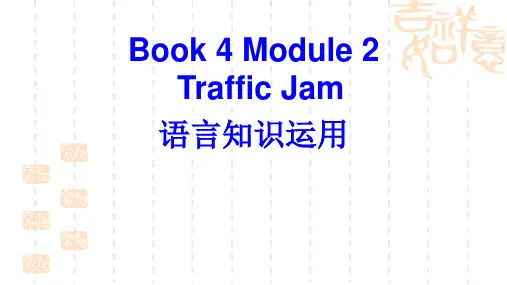
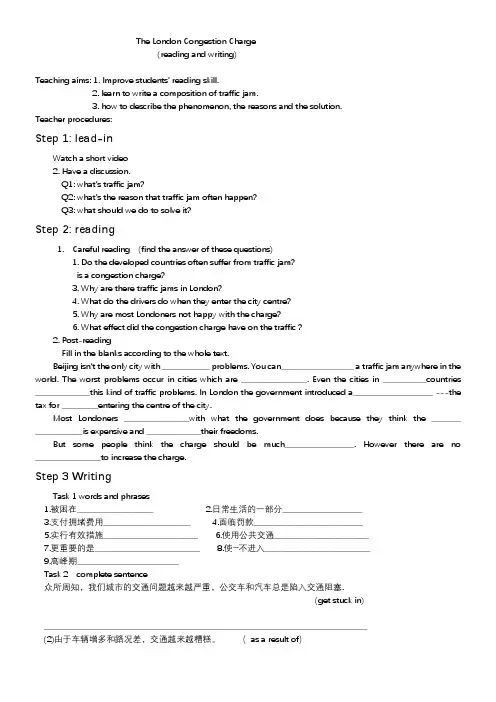
The London Congestion Charge(reading and writing)Teaching aims: 1. Improve students’ reading skill.2. learn to write a composition of traffic jam.3. how to describe the phenomenon, the reasons and the solution.Teacher procedures:Step 1: lead-inWatch a short video2. Have a discussion.Q1: what’s traffic jam?Q2: what’s the reason that traffic jam often happen?Q3: what should we do to solve it?Step 2: reading1.Careful reading (find the answer of these questions)1. Do the developed countries often suffer from traffic jam?is a congestion charge?3. Why are there traffic jams in London?4. What do the drivers do when they enter the city centre?5. Why are most Londoners not happy with the charge?6. What effect did the congestion charge have on the traffic ?2. Post-readingFill in the blanks according to the whole text.Beijing isn‘t the only city with _____________ problems. You can____________________ a traffic jam anywhere in the world. The worst problems occur in cities which are __________________. Even the cities in ____________countries _______________this kind of traffic problems. In London the government introduced a______________________ ---the tax for __________entering the centre of the city.Most Londoners __________________with what the government does because they think the ________ _____________is expensive and _______________their freedoms.But some people think the charge should be much___________________. However there are no __________________to increase the charge.Step 3 WritingTask 1 words and phrases1.被困在_____________________2.日常生活的一部分______________________3.支付拥堵费用________________________4.面临罚款______________________________5.实行有效措施__________________________6.使用公共交通__________________________7.更重要的是_____________________________ 8.使…不进入_____________________________9.高峰期____________________________Task 2 complete sentence众所周知,我们城市的交通问题越来越严重,公交车和汽车总是陷入交通阻塞.(get stuck in)_________________________________________________________________________________________(2)由于车辆增多和路况差,交通越来越糟糕。
Module 2 Traffic Jam i.教学内容分析本模块以Traffic Jam为话题,介绍了北京的各种交通方式及其特点,以及伦敦的城市增容费的问题。
旨在使学生能够运用所学内容描述各种交通方式,讨论与交通有关的话题。
通过本模块学习,学生要对交通问题有所了解,学会写他们所在城市的交通现状以及交通问题。
II .教材重组与课时安排Period one : Introduction & Cultural CornerPeriod two: Reading and VocabularyPeriod three: Vocabulary, Listening and Everyday English,Period four: Function & GrammarPeriod five: Writing.分课时教案Period four: Function & GrammarTeaching Goals:1.To know about the sentence structures about giving advice;To know the usage of the imperatives;2.To learn the meaning of traffic signs.Teaching Difficult Points:1.To know the usage of the imperatives;To learn the meaning of traffic signs.Teaching Important Points:1.To know the usage of the imperatives;To learn the meaning of traffic signs.Teaching procedures:Stepl. Function Ask Ss to read the sentences in Activity 1 on page 13 and summarize the ways of giving advice.You should do ... Make sure you do ... It's a good idea to do ...类似表达还有:You had better do ... Why not do ...? Why don't you do ...?Let's do ... What about...? How about...? Shall I / we do...?1.Ask Ss to write some advice to (heir classmates about learning English.For reference:You should work hard at English.Why don't you buy some English tapes and some books to go with them if you want to improve your listening skills?Lt's a good idea to listen to English songs if you want to improve your listening skill.Make sure you listen to English and speak it every day.Let's read the English novel together.Step 2. Grammar Ask Ss to finish Activity 1 on page 16 to let them know about the usage of the imperatives.1.Present Ss the grammatical rules of the imperatives.(1)用于表达命令、请求、劝告、警告、禁止等的句子叫做祈使句,祈使句最常用于表达命令。
Module 2 Traffic Jam FUNCTIONPeriod 2 FUNCTION--Giving advice■Goals●To learn to give advice■ProceduresStep 1: Getting ready with the structureAsking for AdviceWhat do you think I should do?What do you suggest?What would you do (in this situation)?What advice would you give me if I ….?Giving AdviceI think you should get a lawyer. Maybe you should try someplace else. Why don’t you call the company?If I were you, I would tell her.1. I think you should buy theblue one.2. I don’t think you shou ld sell your car.3. Let’s go bowling tonight.4. Why don’t we go skiing on Saturday?5. Why don’t you come with me to China? That’s a good idea.Thanks for the advice, but I really needthe money.Sorry, I can’t. I’m meeting a friendfor dinner.Sounds like a good idea. Where do you want to go?Thanks, but I’ve already been there.You should…You’d better…Make sure…If I were you, I …It’s a good idea…You’ll …Why not…?If you…, you must…I think…In my opinion, you… Step 2: Giving advice in pairsAdvice on travel on the roadYou should choose your traveling companion carefully.Make sure you consider how you want to travel.It’s a good idea to travel responsibly.Why not travel in as local a way as you can?I think you'll spend less, learn more, and do less ecological damage if you travelwith me.Advice on learning EnglishI think 10 English words or phrases per day aren't too many, are they? Just giveit a try. You will find that you can learn them in next to no time.Why not take a little time each day (Monday to Friday) to learn 10 new words?You may use the weekend to revise what you have learned during the past week(s).This way you'll enrich your English vocabulary by 50 new words per week. (That's200 new English words after a month!)You’d better not look up every word which is new to you —even without a dictionary you will understand a lot. Just concentrate on what you do understand and try tofind out the rest by intelligent guessing.Make sure you also watch the news in your native language and try to find Englishnews to some of the topics. Even if you don't understand every word in the Englishtext, you will get the message as you already know what the text is about.I think it’s a good idea when reading English texts look out for the grammar aspect you want to remember. Mark it and reflect on why it is used there.Why don’t you look up the topic in an English grammar reference, your Englishtextbook?It’s best that you meet friends and study English together. You can repeat yourEnglish vocabulary, do your homework together and help each other with Englishgrammar. And why not try one of our games on ego4u. Studying with friends simplyis much more fun.It's also a good opportunity to exchange ideas on studying in general. Maybe yourfriends have found out about a good way of studying more effectively. Or, who knows, maybe you can advise your friends on this?※A: I like my job, but I don't make enough money.B: You should ask your boss for a raise.A: I don't want to do that. He may fire me.※A: I'd love to buy a Sony tape recorder, but I can't affordit.B: Why don't you buy it on an installment plan?※A: I've got a backache.B: If I were you, I'd see a doctor.※A: Just don't give them a chance to say no.B: Oh, sure, I know that.※A: Be sure to go to the Alitalia office first thing tomorrow.B: good deal.※A: Why can't you and I talk about this later?B: Cool.※A: I feel terrible. I've got a bad hangover.B: I advise you to quit drinking.※A: You've got to learn to put first things first.B: I'll keep that in my mind.。
Teaching PlanModule 2 Reading Getting Around in Beijing(行在北京)Teaching content(教材内容分析):必修4 第二模块的课文”Getting Around in Beijing”介绍了北京市北京公交系统以及相关的车辆情况,并引入了与交通和出行有关的词汇。
通过学习该课文,学生在学习与交通有关的词汇和培养相关的语言技能的同时,将了解北京的交通状况,感受北京的交通问题。
根据学生基础和认知情况把Introduction 和Reading and V ocabulary 整合为一个课时的教学内容。
Teaching goals(教学目的)1.To learn some words about traffic2.To learn to read with some reading strategies3. Improve students’ integrated abilities of listening, speaking ,reading and writing Teaching important points:(教学重点)1.To master some words about traffic such as2.To develop students’reading ability of skimming and scanningTeaching difficult points:(教学难点)How to make students fully understand the textTeaching methods :Brain storm ;task-based teaching ;communicative teaching,individual work;pair work ;group work .Learning strategies :Summarize words and phrases related to traffic ;get and process important information in the course of reading by using the reading abilities of skimming ,scanning and guessing new words from the context .Teaching aids:Multimedia ,a play recorder ,blackboardTeaching procedures:Step 1 Lead in1.Arouse students’interest in the topic Getting around in Beijing by showing them some pictures of places of interest in Beijing.2.Brainstorm means of transportation, and then show some pictures of transport means to review and learn some words related to transport means and traffic .Step 2 Listening1. Improve students’listening ability by listening to the tape, with the task of finding out what means of transportation are mentioned in the tape in mind. (individual work )2. Check answers with students by showing the pictures of transport means mentioned in the text.Step 3 Fast readingFind the main idea of the passage by skimming (individual work )Question: Who might find the information useful?Step 4 Scanning to find some specific information (first individual then pair work ;then check answers with whole class )Read the text again and answer questions according to the text .1. How easy is it to find a taxi in Beijing?2. What color are most taxis?3. What's the problem with buses?4. Which is the best bus for tourists?5. How many people can get in a minibus?6. What are the advantages of the underground?7. When does it close at night?8. What can you visit in a Pedi cab?Step 5 Language pointsDealing with some difficult point by explanation so that students can learn how to use some new words and phrases.Step 6 Practice(individual & pair work)Match the definitions with words (p. 13 Activity 3)Step 7 Group work find the advantages and disadvantages of the five means mentioned in the text by reading the text again .Step 8 DiscussionSuppose you were a visitor to Beijing ,what means of transport would you prefer to use to get around in Beijing .Step 9 Summery & HomeworkMake up a dialogue according to the following situation:运用已知的关于北京交通方面的信息及学到的相关表达,解决实际生活中的问题——你正急于赶飞机却不知道如何安全快速地赶到机场,于是向周围的朋友求助,询问如何在两小时内能够以最佳线路到达机场。
书山有路勤为径;学海无涯苦作舟
外研版高中英语必修4 说课稿Module2 Traffic
Jam
高一英语外研版必修4Module2TrafficJam
说课稿
我给大家说课的内容是高一英语外研版必修4第2模块TrafficJam的ReadingandVocabulary部分课文题目是GettingAroundinBeijing.整个说
课的内容包括六个程序,即学情分析,教材分析、教法学法渗透,学法指导,教学程序,板书设计。
一学情分析
在教学过程中,对学情的了解是教师因材施教的关键。
高中的学生注意
力有一定的稳定性,观察能力很强,具有一定的目的性,系统性和全面性,已经初步实现从具体思维向抽象思维的过渡。
他们喜欢富有个性化的教堂设计,喜欢接受新鲜事。
同时,自我意识增强,拥有强烈的主观能动性。
尤其是课改实施以后,他们更是拥有很强烈的自我展现意识与欲望,不但在乎别人对自己的评价,更渴望得到别人的关注和赞赏。
他们已具有了一定的自主合作和探究的能力,具有了一定的英语语言知识和英语应用的能力,具备了基本的英语思考和英语表达的基本技能。
因此,设计这节课时,我充分考虑到学生的主体性,把自己作为学生一起探讨的一员,以亦师亦友的身份走进他们,以基础的语言启发他们,以轻松的话题开始,以愉快的交流展开合作,充分创造机会让同学们都拥有成功的喜悦,在和谐的氛围中探究并完成教学任务。
二、教材分析
专注下一代成长,为了孩子。
Module 2 Traffic jamusing language---教案教学目标:1. 知识目标:复习拓展与话题Traffic Jam有关的词汇:1) Some means of transportation. eg. coach, trolleybus, cab….2) Some compound nouns eg. ring road, traffic lights, rush hour, bicycle lane, road works, citycen ter…3) Some adjectives rela ted to the speakers’ feelings eg. funny, ridiculous, annoying2. 听力技能目标:学会对听力材料进行一般性信息与重要信息的划分。
3. 口语技能目标:学会谈论自己所在的城市的交通状况。
4. 学会准确地使用imperatives, 并用should, shouldn’t, Why not和Why don’t you 造句。
5. 文化意识与情感态度目标:在了解自己所在城市的交通状况的基础上发现存在的问题,并提出可行的解决办法,从而构建绿色家园。
教学重点与难点:重点:构建词汇网络;训练语境猜词技巧。
难点:灵活运用所学的词汇及表达灵活进行实际交流。
1. 听懂对话中的重要细节。
2. 运用听力对话中出现的交际用语。
3. 使用英语列举学生自己所在城市存在的交通问题并提出解决的办法。
教学方法:情景创设法、任务型教学法、(解决问题型任务,推理型任务,分享个人经验型任务,点阐述型任务)多媒体辅助教学法。
学习方法:在听力训练中指导学生“阅读指令,并对题目的设置进行解读”引导他们借助已有信息和自身的知识背景,对未知内容进行充分的预计。
教学过程:Step1. Introduction:利用情景创设法,通过图片的导入,学习一些与交通工具有关的词汇和一些复合词,为听力做准备让学生知道该听什么, 训练语境猜词技巧。
外研版高中英语必修4说课稿Module2 Traffic
Jam
高一英语外研版必修4Module2TrafficJam
说课稿
我给大家说课的内容是高一英语外研版必修4第2模块TrafficJam的ReadingandVocabulary部分课文题目是GettingAroundinBeijing.整个说课的内容包括六个程序,即学情分析,教材分析、教法学法渗透,学法指导,教学程序,板书设计。
一学情分析
在教学过程中,对学情的了解是教师因材施教的关键。
高中的学生注意力有一定的稳定性,观察能力很强,具有一定的目的性,系统性和全面性,已经初步实现从具体思维向抽象思维的过渡。
他们喜欢富有个性化的教堂设计,喜欢接受新鲜事。
同时,自我意识增强,拥有强烈的主观能动性。
尤其是课改实施以后,他们更是拥有很强烈的自我展现意识与欲望,不但在乎别人对自己的评价,更渴望得到别人的关注和赞赏。
他们已具有了一定的自主合作和探究的能力,具有了一定的英语语言知识和英语应用的能力,具备了基本的英语思考和英语表达的基本技能。
因此,设计这节课时,我充分考虑到学生的主体性,把自己作为学生一起探讨的一员,以亦师亦友的身份走进他们,以基础的语言启发他们,以轻松的话题开始,以愉快的交流展开合作,充分创造机会让同学们都拥有成功的喜悦,在和谐的氛围中探究并完成教学任务。
二、教材分析
1、本模块通过和学生对话的形式,介绍北京的交通状况,如交通工具、交。